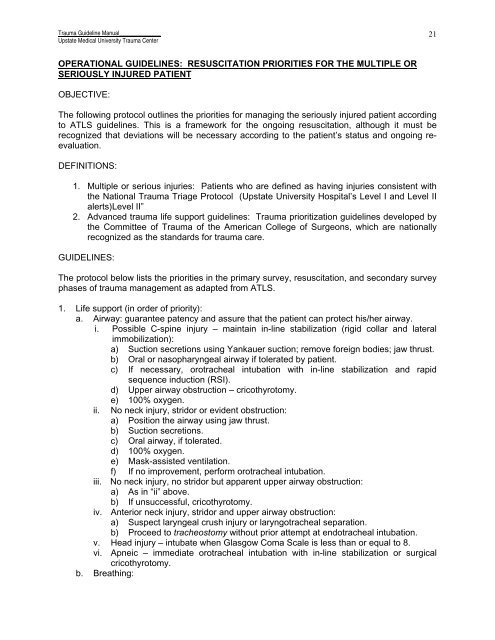Trauma Guideline Manual - SUNY Upstate Medical University
Trauma Guideline Manual - SUNY Upstate Medical University
Trauma Guideline Manual - SUNY Upstate Medical University
Create successful ePaper yourself
Turn your PDF publications into a flip-book with our unique Google optimized e-Paper software.
<strong>Trauma</strong> <strong>Guideline</strong> <strong>Manual</strong>______________<strong>Upstate</strong> <strong>Medical</strong> <strong>University</strong> <strong>Trauma</strong> Center21OPERATIONAL GUIDELINES: RESUSCITATION PRIORITIES FOR THE MULTIPLE ORSERIOUSLY INJURED PATIENTOBJECTIVE:The following protocol outlines the priorities for managing the seriously injured patient accordingto ATLS guidelines. This is a framework for the ongoing resuscitation, although it must berecognized that deviations will be necessary according to the patient’s status and ongoing reevaluation.DEFINITIONS:1. Multiple or serious injuries: Patients who are defined as having injuries consistent withthe National <strong>Trauma</strong> Triage Protocol (<strong>Upstate</strong> <strong>University</strong> Hospital’s Level I and Level IIalerts)Level II”2. Advanced trauma life support guidelines: <strong>Trauma</strong> prioritization guidelines developed bythe Committee of <strong>Trauma</strong> of the American College of Surgeons, which are nationallyrecognized as the standards for trauma care.GUIDELINES:The protocol below lists the priorities in the primary survey, resuscitation, and secondary surveyphases of trauma management as adapted from ATLS.1. Life support (in order of priority):a. Airway: guarantee patency and assure that the patient can protect his/her airway.i. Possible C-spine injury – maintain in-line stabilization (rigid collar and lateralimmobilization):a) Suction secretions using Yankauer suction; remove foreign bodies; jaw thrust.b) Oral or nasopharyngeal airway if tolerated by patient.c) If necessary, orotracheal intubation with in-line stabilization and rapidsequence induction (RSI).d) Upper airway obstruction – cricothyrotomy.e) 100% oxygen.ii.No neck injury, stridor or evident obstruction:a) Position the airway using jaw thrust.b) Suction secretions.c) Oral airway, if tolerated.d) 100% oxygen.e) Mask-assisted ventilation.f) If no improvement, perform orotracheal intubation.iii. No neck injury, no stridor but apparent upper airway obstruction:a) As in “ii” above.b) If unsuccessful, cricothyrotomy.iv. Anterior neck injury, stridor and upper airway obstruction:a) Suspect laryngeal crush injury or laryngotracheal separation.b) Proceed to tracheostomy without prior attempt at endotracheal intubation.v. Head injury – intubate when Glasgow Coma Scale is less than or equal to 8.vi. Apneic – immediate orotracheal intubation with in-line stabilization or surgicalcricothyrotomy.b. Breathing:
















